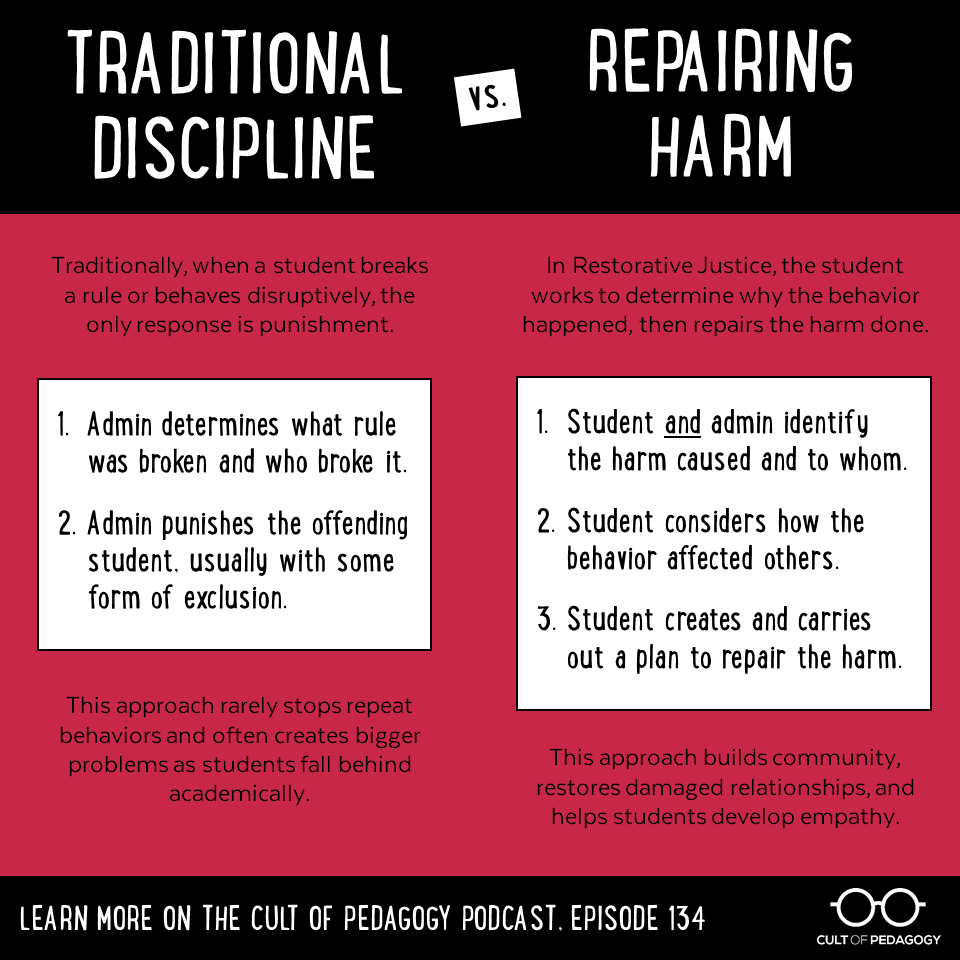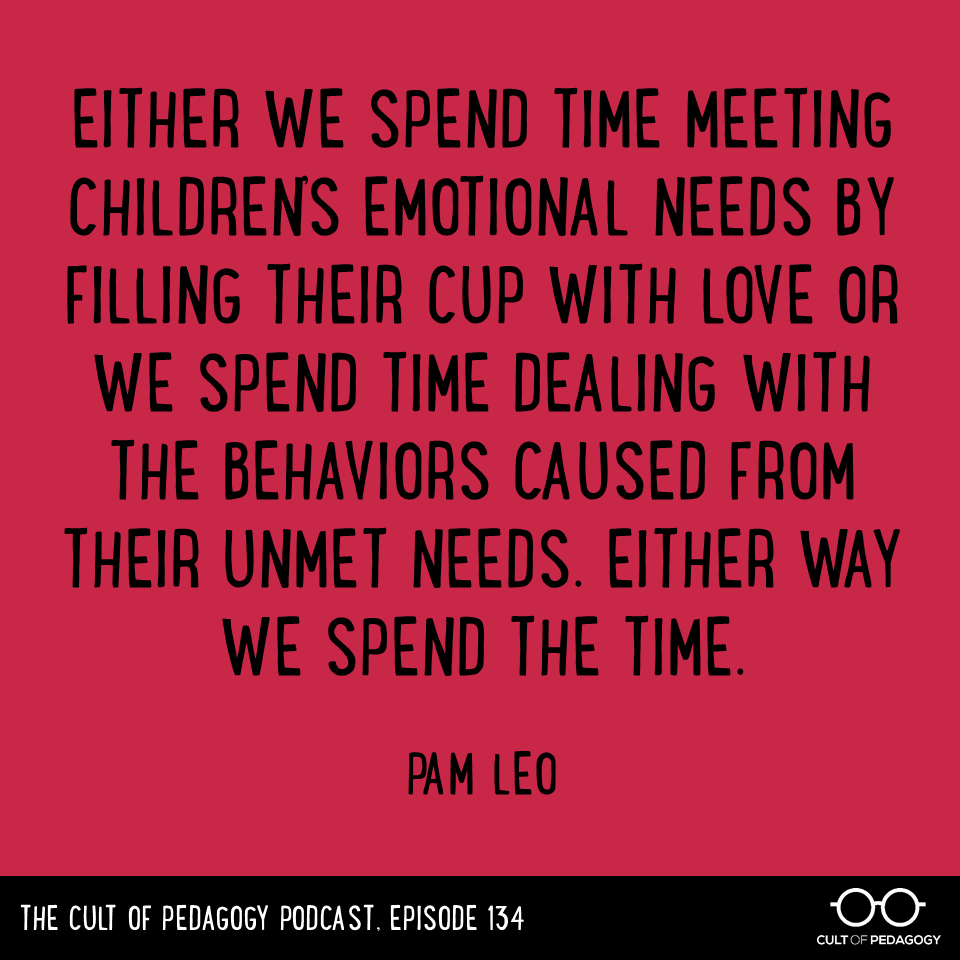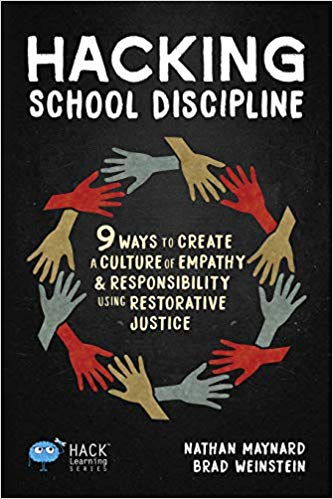Take heed to my interview with Nathan Maynard
and Brad Weinstein (transcript):
Sponsored by Public Consulting Group and ViewSonic
This put up incorporates Amazon Affiliate hyperlinks. Whenever you make a purchase order via these hyperlinks,
Cult of Pedagogy will get a small share of the sale at no further value to you.
When college students behave in methods which might be disruptive, after they do issues that hurt others, or after they in any other case make decisions that go towards established guidelines, colleges typically reply with punishment: elimination from class, a telephone name house, detention, suspension, even expulsion if the habits is taken into account excessive sufficient.
It’s been this manner endlessly, at the least in conventional western colleges, and more often than not, these punishments don’t actually work. Positive, they take away the coed from the state of affairs, briefly stopping the difficult habits. And it might be argued that generally, many college students select to observe the principles as a result of the specter of punishment acts as a deterrent; they don’t wish to get in hassle, so a suitable stage of order is maintained.
However punishments don’t actually do something to handle or appropriate the supply of the misbehavior, and more often than not, they do nothing to repair any harm that will have been attributable to it. On high of that, exclusionary punishments like suspensions create their very own set of issues: When college students are faraway from class, they miss instruction, placing them behind their classmates and making them extra more likely to fail academically. This typically results in larger dropout charges and places far too many college students—particularly college students of coloration—on the trail to jail.
After many years of utilizing these ineffective practices, extra colleges are turning to restorative justice, an strategy to pupil habits that originated within the felony justice system. In 2018, Victor Small, Jr and I did a broad overview of Restorative Justice to go over the fundamentals.
Now I’m going to slim the lens to 1 particular restorative apply known as repairing hurt. That is when, as a substitute of merely being despatched off to a punishment, a pupil who has misbehaved is tasked with determining find out how to restore no matter harm was attributable to their habits, after which to really perform that restore with everybody who was impacted by their actions.
To find out about this apply, I talked to Brad Weinstein and Nathan Maynard, authors of the e book Hacking Faculty Self-discipline: 9 Methods to Create a Tradition of Empathy & Duty Utilizing Restorative Justice. Weinstein is a former classroom trainer and administrator, and Maynard began his profession within the juvenile justice system earlier than going into instructing. Now they work collectively at Habits Flip, a digital habits administration system constructed on the rules of restorative justice.


Of their e book, Brad and Nathan share the restorative justice methods they’ve used efficiently for years with college students. In our dialog (which you’ll be able to hearken to above), they took me step-by-step via a type of methods: the method of repairing hurt after a misbehavior as a substitute for punishment.
How Repairing Hurt Works
1. Determine the Hurt and the Stakeholders
After an incident has occurred, the coed meets with the administrator or different grownup answerable for habits administration. In a non-public convention, the 2 work collectively to determine the hurt attributable to the habits and all the stakeholders who have been impacted by it.
This listing of stakeholders typically seems to be longer than the coed first thought.
“Lots of occasions college students don’t perceive {that a} habits has a ripple impact,” Maynard says. “Like throwing a rock right into a pond, it impacts a whole lot of totally different folks. We have now to indicate them what these ripples are and who these actually are affecting, so after they’re repairing the hurt they want to consider every stakeholder individually. That’s creating the empathy abilities for every certainly one of them.”
2. Take into account How the Habits Affected Others
As soon as all stakeholders have been recognized, it’s time for the coed to assume deeply about how all of them have been impacted by the habits. This train in empathy will assist the coed give you the precise restore later.
Generally this course of requires assist from the adults. Maynard describes what this might appear to be, beginning by saying one thing to the coed alongside these traces: “Whenever you toss stuff in a category, and let’s say that hits another person, how do you assume their mom would really feel if I known as them up and mentioned, hey their son simply received damage in school? One thing like that that’s going to drive the empathy and create that sense of, oh, one other stakeholder is that child’s dad or mum.”

3. Create and Carry Out a Plan to Restore the Hurt
Lastly, the coed—not the administrator—creates a plan to restore the hurt with each stakeholder. The plan doesn’t need to be something elaborate; it may be so simple as an apology.
“Let’s say a pupil was yelling on the class,” Maynard says. “That impacts the remainder of the category. What are you able to do to restore it (with them)? Generally I’ve had college students go in entrance of the category and simply apologize. One thing like that—proudly owning that habits—reveals the remainder of the category that it’s not acceptable.”
Though some may see this as getting off straightforward, contemplate the braveness it takes to face up in entrance of your friends and publicly admit wrongdoing. “I imply,” Maynard says, “that’s much more robust than sitting at house for 3 days.”
There are occasions, although, when sorry isn’t sufficient. “Prime instance, pupil throws meals throughout the cafeteria,” Weinstein says. “They spill milk all around the ground, they trigger a giant mess. If they only say, I’m sorry, you simply say, I’m glad that you just apologized, however I feel we’re going to need to do one thing slightly bit extra, since you prompted a large number. Who’re the stakeholders? They could notice that there’s anyone that has to wash up after them, and so they’re going to remove time from their job—as anyone who cleans the tables, I’ve to go house 20 minutes late now, as a result of I’m cleansing your mess.”
Weinstein says in circumstances like this, the answer “may appear to be cleansing all the tables, mopping the ground, and dealing with the custodian to assist clear, as a result of after they trigger hurt to the atmosphere, a great way to restore that hurt is to make that atmosphere clear. If I have been to only put (the coed) in detention or ISS for the remainder of the day, that will educate that child to not get caught subsequent time. They wouldn’t have any understanding of who they damage, why what they did was a nasty factor, and the way they will restore that hurt.”
Questions About this Course of
Gained’t this take further time?
It is dependent upon the way you take a look at it. Punishment is certainly faster than working with a pupil to think about the influence of habits on stakeholders and develop a plan for restore. However as a result of conventional punishment doesn’t normally finish the habits, you’re more likely to spend extra time on it later.
“An Edutopia article only recently got here out that claims classroom administration takes about 144 minutes per week out of (tutorial time),” Maynard says. “So if you consider 144 minutes per week, take into consideration what are you able to do to combine these proactive approaches and meet these children’ wants.”
This concept is captured within the quote that begins the e book’s chapter on repairing hurt, from writer Pam Leo: “Both we spend time assembly kids’s emotional wants by filling their cup with love or we spend time coping with the behaviors prompted from their unmet wants. Both means we spend the time.”

What if the coed denies the habits?
Generally a pupil will flat-out deny having carried out the factor they’re being accused of doing. This could even occur if you, the trainer, have been an eye fixed witness.
When this occurs, Maynard offers college students two decisions. “I say, okay. I consider this was you, and if I’m unsuitable, I’m unsuitable. Let’s cope with this example now, repair it, transfer ahead. Proper now it’s simply between me and also you. If I discover out later that it’s you, then there’s simply going to be an extra state of affairs. Why not simply cope with it proper from time to time if there’s an extra state of affairs that’s exhibiting that you just’re dishonest, (then) I’ve to cope with what occurred and you being dishonest, as a substitute of simply what occurred. You make the selection.”
Afterwards, he all the time offers college students time to course of, to consider what they wish to do. “As a result of instantly if I say one thing like that, they’re nonetheless going to be oppositional,” he explains. “So I give them a while to course of what’s happening. I again away, say okay, I’m going to present you a couple of minutes.”
When he does this, Maynard says, college students will typically settle down and change into extra cooperative. “Giving them that point actually does assist out.”
Shouldn’t Individuals Endure at Least a Little Bit After Doing One thing Flawed?
When somebody misbehaves, our logic tells us that they need to expertise some sort of unfavourable consequence; in any other case how will they study to not do it once more?
On high of that’s the truth that we’re all human. After a pupil has disrespected us or prompted an issue for us, we would truthfully begin itching for a little bit of revenge.
“Punishment makes us really feel higher generally,” Maynard says. “You recognize, somebody did one thing unsuitable, they harmed me, I would like there to be some type of hurt. We’ve heard somebody say earlier than, you disrespected me, so now you have to undergo slightly bit.”
However beneath that feeling is a want to have the coed expertise actual remorse, a remorse that may be deeper and longer-lasting if it emerges within the pupil from a spot of empathy.
“That assertion reveals that (academics) do wish to present the scholars find out how to be empathetic and notice how they felt.” Maynard says. “Restorative apply is the best way to try this, but it surely’s simply much less traumatic. And it’s a far more efficient approach to open up that little one’s eyes to how their habits made us really feel.”
To study extra, observe Nathan on Twitter at @NmaynardEdu and Brad at @WeinsteinEdu, go to their web site at hackingschooldiscipline.com, be part of their Hacking Faculty Self-discipline Fb group, and discover their app, BehaviorFlip, at behaviorflip.com.
Be a part of our mailing listing and get weekly ideas, instruments, and inspiration that can make your instructing simpler and enjoyable. You’ll get entry to our members-only library of free downloads, together with 20 Methods to Minimize Your Grading Time in Half, the e-booklet that has helped 1000’s of academics save time on grading. Over 50,000 academics have already joined—come on in.


